Goal:
Identify unusual/weird events that have a high chance of being a fraud with credit card transactions.
import pandas as pd
import numpy as np
from sklearn.cluster import KMeans
1: Customer incentive policy
1-1. Aim
Enlarge money flow by automatically increasing their limit
1-2. Method
Identify target users that never went above the monthly credit card limit (calendar month).
general_info = pd.read_csv('./cc_info.csv')
transaction = pd.read_csv('./transactions.csv',parse_dates=['date'])
general_info.head()
transaction['month'] = pd.to_datetime(transaction['date'],format = '%Y%m%d')
transaction['month'] = transaction['month'].dt.month
transaction.head()
## collect monthly amount for each card holder
credit = pd.merge(general_info,transaction,on = ['credit_card'])
credit.head()
task1 = credit.groupby(['month','credit_card']).agg({'credit_card_limit':'min','transaction_dollar_amount':'sum'})
task1.reset_index(inplace = True)
task1 = task1.loc[(task1['transaction_dollar_amount']<=task1['credit_card_limit'])]
over_limit_user = task1['credit_card'].unique()
### Ratio of identified card holders
over_limit_user.size/credit['credit_card'].unique().size
### details for over limit holders monthly transaction which are over amount
print(task1)
month credit_card credit_card_limit transaction_dollar_amount
0 7 1003715054175576 20000 162.56
1 7 1013870087888817 15000 281.43
2 7 1023820165155391 28000 943.26
3 7 1073931538936472 10000 220.07
4 7 1087468642191606 3000 241.60
... ... ... ... ...
3791 10 9946917923319410 15000 10174.10
3792 10 9958678964376192 10000 5623.22
3793 10 9961694231875562 10000 5442.72
3794 10 9981251982982618 18000 12959.72
3795 10 9986135779184360 14000 11796.95
[3571 rows x 4 columns]
2 : Increase retention
2-1. Aim:
Decrease the punishment by setting a remind for users to pay their bills.
2-2. Method:
Build a function that for each day, returns a list of users who went above their credit card monthly limit on that day
def credit_alarm(date):
month = date.month
print(month)
task2 = credit.groupby(['month','credit_card']).agg({'credit_card_limit':'min','transaction_dollar_amount':'sum'})
task2.reset_index(inplace = True)
users = task2.loc[(task2['month'] == month) & (task2['transaction_dollar_amount']>task2['credit_card_limit'])]['credit_card']
return users.unique()
# test with example: 2015-10-29 18:23:04
date = pd.to_datetime(['2015-10-29 18:23:04'])
credit_alarm(date[0])
10
array([1106824181265726, 1460880989446247, 1749458277555747,
1934150487562155, 2245942585429940, 2302576486327459,
2366928097135853, 2505223645294729, 2610112472096585,
2891791194252089, 2980539633198204, 3138132199016625,
3264419298955673, 3276369883343727, 3355576223096097,
3369600965634913, 3370960377586437, 3546693056773873,
3676109815092640, 3797102737432115, 3929517687134990,
3936887050542904, 4052848131106690, 4118286032166087,
4298557099672376, 4318352196714983, 4462290711836916,
4973517790485920, 5199442973583621, 5257380962581683,
5488856737032471, 5612235316109460, 5723635641134781,
5795626689544539, 5899644472359642, 5915891114492596,
5975270769354417, 5996982621454469, 6174559182308122,
6198761755487915, 6292410823269309, 6358192544004241,
6497866359354370, 6766253113444560, 6984795534098127,
7107467078128879, 7198750113791865, 7214837915436490,
7238936669483666, 7266500047328736, 7280963829231048,
7299183791723634, 7324887971716592, 7338934618553557,
7492940622489570, 7499289351166761, 7545819552904208,
7556827548313098, 7762807525339038, 7850942767136368,
7922818627489943, 7924297455503050, 7943675133681182,
8117664962797683, 8138690656185482, 8522875529951473,
8660372645853870, 8766575362057055, 8896425420278012,
8972201384562696, 9143914562725960, 9213346056999744,
9484591448272784, 9577424157559810, 9632319271199136,
9727202337611852, 9999757432802760])
3: Fraud Detection
3-1: Aim
detect all transactions that seem unusual and are worth being investigated further
3-2: Method
implement an unsupervised algorithm (PCA + K-Means)
Feature Engineering + PCA + Building Model
### 1. transform register zip code to [longitude,latitude]
from geopy.geocoders import Nominatim
credit['register_place'] = credit['city']+','+credit['state']
credit['trans_place'] = credit[['Lat','Long']].values.tolist()
geolocator = Nominatim(user_agent="custering")
#adding longituede,latitude information to cities
#since we have over 290000 records but only have 124 distinct cities.
cities = credit['register_place'].unique()
df = pd.DataFrame({'name': cities})
from geopy.geocoders import Nominatim
geolocator = Nominatim(user_agent="clustering")
from geopy.extra.rate_limiter import RateLimiter
geocode = RateLimiter(geolocator.geocode, min_delay_seconds=1)
df['location'] = df['name'].apply(geocode)
df['point'] = df['location'].apply(lambda x:[x.latitude,x.longitude] if x else None)
df.head()
#merging back to credit and remove duplicate grographic columns
df = pd.merge(credit[['credit_card','credit_card_limit','transaction_dollar_amount','register_place','trans_place']],df[['name','point']],left_on = ['register_place'],right_on = ['name'])
df['register_place'] = df['point']
df
### 2. calculate the distance between resgiered place and transaction place
from geopy.distance import geodesic
df['distance'] = df.apply(lambda x: geodesic(x['register_place'], x['trans_place']).km, axis=1)
df.head()
def stst_percentile(x):
ps = [25,50,75]
res = np.percentile(x,ps)
return pd.Series(res,index = ['{}%'.format(p) for p in ps])
percent = credit.groupby(['credit_card'])['transaction_dollar_amount'].apply(stst_percentile).unstack()
percent.head()
credit_df = pd.merge(df,percent,on= ['credit_card'])
credit_df.to_csv('./credit_df.csv',index = False)
### 1. Clustering: PCA+ k-means
credit_df.head()
from sklearn.preprocessing import scale
#standarization
feature = ['credit_card_limit','transaction_dollar_amount','distance','25%','50%','75%']
X = credit_df[feature]
X = scale(X)
import matplotlib.pyplot as plt
from sklearn.decomposition import PCA
pca = PCA(n_components=2)
PrincipleComp = pca.fit_transform(X)
x2d = pd.DataFrame(PrincipleComp,columns=['pc1','pc2'])
plt.scatter(x2d.pc1,x2d.pc2,alpha = 0.1)
from mpl_toolkits.mplot3d import Axes3D
pca = PCA(n_components=3)
PrincipleComp = pca.fit_transform(X)
x3d = pd.DataFrame(PrincipleComp,columns=['pc1','pc2','pc3'])
fig = plt.figure()
ax = Axes3D(fig, rect=[0, 0, 1, 1], elev=30, azim=20)
plt.scatter(x3d['pc1'], x3d['pc2'], x3d['pc3'],marker='o')
/opt/anaconda3/lib/python3.8/site-packages/matplotlib/collections.py:886: RuntimeWarning: invalid value encountered in sqrt
scale = np.sqrt(self._sizes) * dpi / 72.0 * self._factor
<mpl_toolkits.mplot3d.art3d.Path3DCollection at 0x7fa64d01cc10>

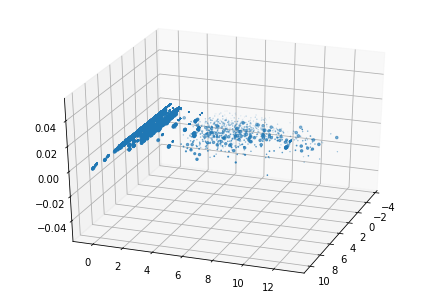
Tuning Hyperparameter
#hyperparameter k selection
inertia = []
for k in range(1, 8):
kmeans = KMeans(n_clusters=k, random_state=1).fit(X)
inertia.append(np.sqrt(kmeans.inertia_))
plt.plot(range(1, 8), inertia, marker='s');
plt.xlabel('$k$')
plt.ylabel('$J(C_k)$');

## K-means to cluster
n_clusters = 6
kmeans = KMeans(n_clusters = n_clusters).fit(x3d)
x3d['label'] = kmeans.labels_
x3d['label'].value_counts()
import itertools
colors = itertools.cycle( ['r','g','b','c','m','y','k'] )
fig = plt.figure(figsize = (12,10) )
ax = Axes3D(fig, rect=[0, 0, 1, 1], elev=30, azim=20)
ax.set_xlim3d(-5, 10)
for label in range(n_clusters) :
temp = x3d.loc[x3d.label == label,:]
plt.scatter(temp.pc1,temp.pc2,temp.pc3, c=next(colors),label=label,alpha=0.3,marker='o')
plt.legend(loc='best')
plt.show()
/opt/anaconda3/lib/python3.8/site-packages/matplotlib/collections.py:886: RuntimeWarning: invalid value encountered in sqrt
scale = np.sqrt(self._sizes) * dpi / 72.0 * self._factor
/opt/anaconda3/lib/python3.8/site-packages/matplotlib/collections.py:886: RuntimeWarning: invalid value encountered in sqrt
scale = np.sqrt(self._sizes) * dpi / 72.0 * self._factor
/opt/anaconda3/lib/python3.8/site-packages/matplotlib/collections.py:886: RuntimeWarning: invalid value encountered in sqrt
scale = np.sqrt(self._sizes) * dpi / 72.0 * self._factor
/opt/anaconda3/lib/python3.8/site-packages/matplotlib/collections.py:886: RuntimeWarning: invalid value encountered in sqrt
scale = np.sqrt(self._sizes) * dpi / 72.0 * self._factor
/opt/anaconda3/lib/python3.8/site-packages/matplotlib/collections.py:886: RuntimeWarning: invalid value encountered in sqrt
scale = np.sqrt(self._sizes) * dpi / 72.0 * self._factor
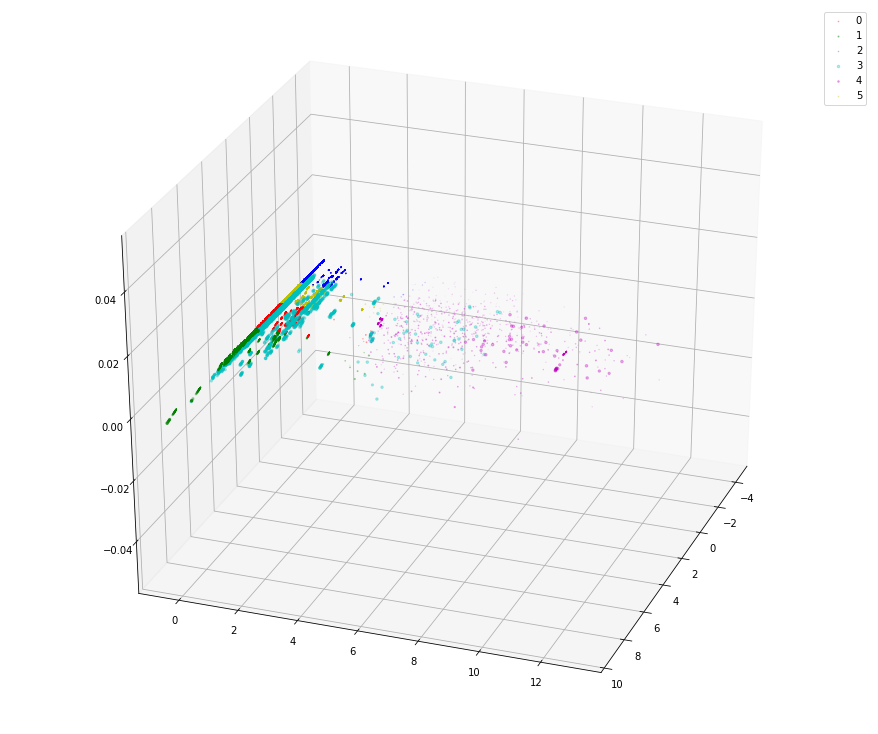
## check the distribution of x3d labels
x3d.label.value_counts()
5 113127
2 73124
0 70056
1 27449
4 5445
3 5387
Name: label, dtype: int64
Comparing the distribution of two core features among classified two clusters
suspicious_label=4
suspect = credit_df.loc[x3d.label ==4]
suspect.to_csv('./suspect',index = False)
cols = ["transaction_dollar_amount",'75%']
plt.hist(suspect.loc[:,cols].values,bins=50,label=cols)
plt.legend(loc='best')
plt.show()
unsuspect = credit_df.loc[x3d.label !=3]
plt.hist(suspect.loc[:,['distance']].values,bins=50,density = True,label = 'suspect')
plt.hist(unsuspect.loc[:,['distance']].values,bins=50,density = True,label = 'unsuspect')
plt.legend(loc='best')
plt.show()
### deleting 0 distance and replot
unsuspect = unsuspect.loc[unsuspect.distance>100]
plt.hist(suspect.loc[:,['distance']].values,bins=50,density = True,label = 'suspect')
plt.hist(unsuspect.loc[:,['distance']].values,bins=50,density = True,label = 'unsuspect')
plt.legend(loc='best')
plt.show()
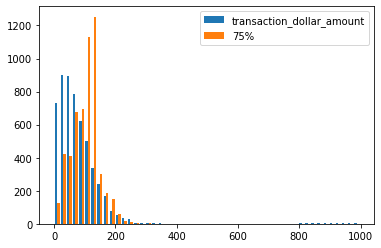
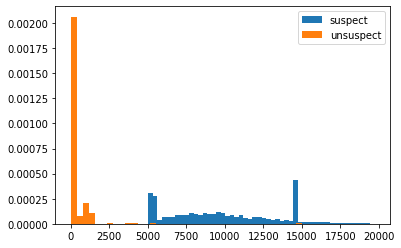
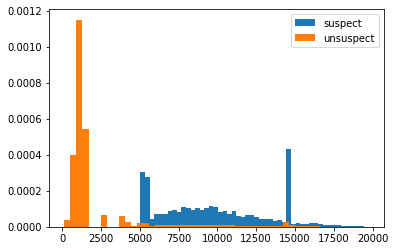
quantify the effect of fraud transactions
#ratio of suspectious fraud transactions
suspect.shape[0]/credit_df.shape[0]*100
1.8483441280703898
#total amount of suspectious fraud transactions
suspect['transaction_dollar_amount'].sum()
444493.55000000005
non-parametric & parametric tests
Aim: check whether the mean of suspect and non-suspect team are different.
#for diatance
dis_x = suspect['distance']
dis_y = unsuspect['distance']
#z-test
from statsmodels.stats.weightstats import ztest
r1 = ztest(dis_x,dis_y)
print(r1)
#Mann Whitney U Test
from scipy.stats import mannwhitneyu
r2 = mannwhitneyu(dis_x,dis_y)
print(r2)
(184.11775527497144, 0.0) MannwhitneyuResult(statistic=14921897.5, pvalue=0.0)
#for total_amount
dis_x = suspect['transaction_dollar_amount']
dis_y = unsuspect['transaction_dollar_amount']
#z-test
from statsmodels.stats.weightstats import ztest
r1 = ztest(dis_x,dis_y)
print(r1)
#Mann Whitney U Test
from scipy.stats import mannwhitneyu
r2= mannwhitneyu(dis_x,dis_y)
print(r2)
(11.961471627328077, 5.655073132421734e-33) MannwhitneyuResult(statistic=137735388.0, pvalue=1.5637055034033401e-15)